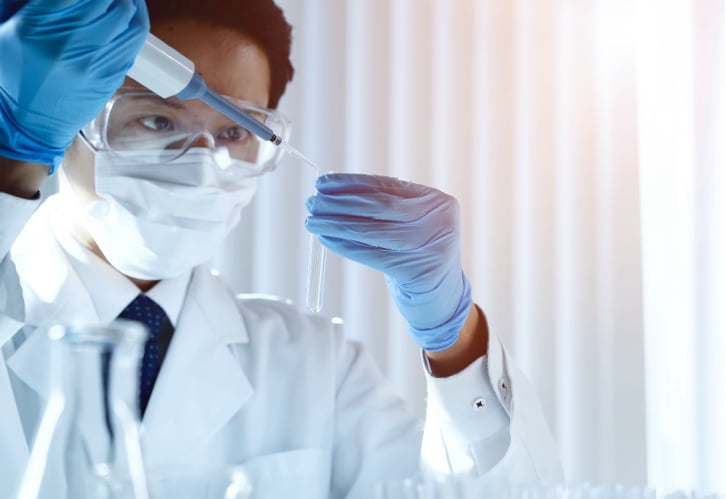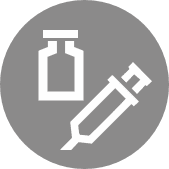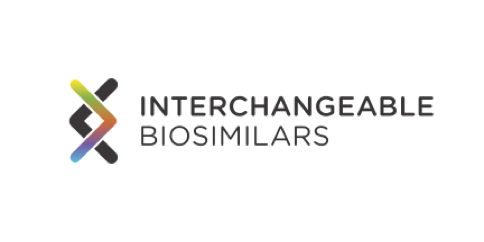A biosimilar is a biological product that is highly similar to and has no clinically meaningful differences from an existing FDA-approved reference product.1 Biosimilars have been shown to decrease healthcare costs and improve patient access.2
Find out what INTERCHANGEABILITY can mean for you.

Biosimilars, like all biologics, are cultured in living cells1
Biosimilars are tested hundreds of times during production to ensure purity,
stability, and potency.3
Like a reference biologic, no 2 batches of a biosimilar are exactly alike. That’s why the term “generic” can’t be applied to a biosimilar. And that’s why rigorous quality control is so important.4,5
Biologics are produced using a sophisticated, highly technical, multistep process.6,7

Step 1: Small Scale
A high-quality biologic or biosimilar
is extracted from living cells by a
robotics system.

Step 2: Large Scale
The cells are grown to a significant
volume in bioreactors.

Step 3: Purification
The biologic or biosimilar goes through
multiple purification steps, such as
filtration and chromatography.

Step 4: Finished Product
The biologic or biosimilar is securely
filled in sterile vials, syringes, or
auto-injectors.
Technological advances allow for biosimilar makers to utilize more sensitive assays that can often characterize the reference molecule more fully than when it was initially introduced8
Testing has evolved over the last 20 years, which provides a better indication of the similarities of profiles between biologics and their proposed biosimilars.8
These tests include amino acid composition analysis, nuclear magnetic resonance testing, mass spectrometry, peptide mapping, complement-dependent cytotoxicity assays, antibody-dependent cell-mediated cytotoxicity assays, reverse signaling assays, and many more.9
The increased sensitivity of tests can yield a deeper understanding of key qualities of the reference molecule compared to when it was first made.8
Below is an example of one type of test, a peptide mapping test.
Example: Peptide mapping chromatogram10

A peptide mapping test is used to confirm that an amino acid sequence between a US reference biologic, EU reference biologic, and proposed biosimilar version of the US reference biologic is identical.10 In this test, the profile of the biosimilar matches different batches of the reference biologic very closely.
Multiple tests are performed to ensure biosimilarity to a reference product.
To demonstrate comparable quality of a biosimilar product, a series of analytical tests are used to compare the physicochemical (both physical and chemical properties) and biological qualities.10
While many of these differences can be characterized with current analytical techniques, others cannot. The potential for these differences to affect clinical safety and efficacy of the product should then be analyzed in clinical trials, as reflected in the current regulatory approval standards for biosimilars.10

The differences and similarities between a reference biologic
and
a biosimilar11-13

The totality of evidence to prove biosimilarity
Biosimilars take 7-8 years to develop.14
Traditional, small-molecule generic drugs require bioequivalence tests to gain approval, which typically take about 2 years. Reference biologic medicines can take 10 years or more to develop, requiring rigorous and costly de novo testing of efficacy and safety.4,15,16
As biologics, biosimilars are complex and difficult to characterize, requiring more extensive data than generics. However, biosimilars are less time-consuming and less costly to develop than reference biologics.1,4
The FDA looks at the totality of evidence to demonstrate the safety, purity, and potency of a biosimilar candidate.1

Extrapolation: Helping to improve patient access to biologic medicines
Part of the FDA’s abbreviated pathway for biosimilar approval is based on the concept of extrapolation.17
Extrapolation means that a biosimilar may be clinically tested in only one indication. If that trial is successful, safety and efficacy may be extrapolated for additional eligible indications—indications for which the reference biologic has already been tested in clinical studies and approved.17
FDA guidelines recommend testing in the most sensitive indication for which the reference biologic is prescribed, using a homogeneous patient population. This helps to identify any response variations rapidly and definitively.18

Frequently Asked Questions
Yes, given the extensive testing and totality of evidence, the FDA allows for extrapolation to other indications in which the reference product has been studied. In the European Union, where biosimilars have been available since 2006, there have been over 700 million patient-days of treatment with biosimilars with no new safety or efficacy concerns that were not already known for the reference biologic.17,19
Based on FDA guidance the objective of the trial is to demonstrate biosimilarity, not independently establish safety and efficacy of the biosimilar candidate. Indication, patient population, and clinical endpoints are the foundation for a Phase 3 biosimilar candidate trial. A homogeneous population is considered to minimize variability in patient- and disease-related factors relative to the population studied for licensure of the reference product. A sensitive indication is important, along with a large effect size that is easily measurable and an endpoint that is sensitive to the drug effect.18,20,21
References:
-
1. US Food & Drug Administration website. Biological product definitions. https://www.fda.gov/files/drugs/published/Biological-Product-Definitions.pdf. Accessed November 1, 2022.
-
2. Mulcahy AW, Predmore Z, Mattke S. The cost savings potential of biosimilar drugs in the United States. RAND Corporation. https://www.rand.org/content/dam/rand/pubs/perspectives/PE100/PE127/RAND_PE127.pdf. Accessed November 1, 2022.
-
3. Biopharm International website. Biologics: Can there be abbreviated
applications, generics, or follow-on products? https://www.biopharminternational.com/view/biologics-can-there-be-abbreviated-applications-generics-or-follow-products. Accessed November 1, 2022. -
4. US Food & Drug Administration website. Biosimilar and interchangeable products. https://www.fda.gov/drugs/biosimilars/biosimilar-and-interchangeable-products. Accessed November 1, 2022.
-
5. US Food & Drug Administration website. Biosimilar Product Regulatory
Review and Approval. https://www.fda.gov/files/drugs/published/Biosimilar-Product-Regulatory-Review-and-Approval.pdf. Accessed November 1, 2022. -
6. Ryan AM. Frontiers in nonclinical drug development: biosimilars. Vet Pathol. 2015;52(2):419-426.
-
7. Boehringer Ingelheim website. The biotechnology manufacturing process at a glance (e.g. manufacturing of antibodies). https://www.bioxcellence.com/about_us/about_biotechnology/manufacturing_process_glance.html. Accessed November 1, 2022.
-
8. Fischer SK, Joyce A, Spengler M, et al. Emerging technologies to increase ligand binding assay sensitivity. AAPS J. 2015;17(1):93-101.
-
9. Visser J, Feuerstein I, Stangler T, et al. Physicochemical and functional comparability between the proposed biosimilar rituximab GP2013 and originator rituximab. BioDrugs. 2013;27(5):495-507.
-
10. Research Advocacy website. Introduction to biosimilar medicines. https://researchadvocacy.org/sites/default/files/resources/Biosimilar%20Medicines6_4Final.pdf. Accessed November 22, 2022.
-
11. Weise M, Bielsky MC, De Smet K, et al. Biosimilars: what clinicians should know. Blood. 2012;120(26):5111-5117.
-
12. Lucio SD, Stevenson JG, Hoffman JM. Biosimilars: primer for the health-system pharmacist. Am J Health Syst Pharm. 2013;70(22):2004-2017.
-
13. Markus R, Liu J, Ramchandani M, et al. Developing the totality of evidence for biosimilars: regulatory considerations and building confidence for the healthcare community. BioDrugs. 2017;31(3):175-187.
-
14. Blackstone E, Fuhr JP. The economics of biosimilars. Business.
2013;6(8):469-478. -
15. Renwick MJ, Smolina K, Gladstone EJ, et al. Postmarket policy
considerations for biosimilar oncology drugs. Lancet Oncol. 2016;17(1):e31-38. -
16. PhRMA website. BioPharmaceutical research & development: The process behind new medicines. http://phrma-docs.phrma.org/sites/default/files/pdf/rd_brochure_022307.pdf. Accessed November 1, 2022.
-
17. US Food & Drug Administration website. Biosimilar development, review, and approval. https://www.fda.gov/drugs/biosimilars/biosimilar-development-review-and-approval. Accessed November 1, 2022.
-
18. US Food & Drug Administration website. Scientific considerations in demonstrating biosimilarity to a reference product. https://www.fda.gov/regulatory-information/search-fda-guidance-documents/scientific-considerations-demonstrating-biosimilarity-reference-product. Accessed November 1, 2022.
-
19. The Hill website. Biosimilar drugs offer promise for US health care system. https://thehill.com/opinion/healthcare/353498-biosimilar-drugs-offer-promise-for-us-health-care-system/. Accessed November 1, 2022.
-
20. US Food & Drug Administration website. FDA’s overview of the regulatory
guidance for the development and approval of biosimilar products in the US. https://www.fda.gov/files/drugs/published/FDA%E2%80%99s-Overview-of-the-Regulatory-Guidance-for-the-Development-and-Approval-of-Biosimilar-Products-in-the-US.pdf. Accessed November 1, 2022. -
21. EMA Europe website. Guideline on similar biological medicinal products
containing monocloncal antibodies – non-clinical and clinical issues. https://www.ema.europa.eu/en/documents/scientific-guideline/guideline-similar-biological-medicinal-products-containing-monoclonal-antibodies-non-clinical_en.pdf. Accessed November 1, 2022.
